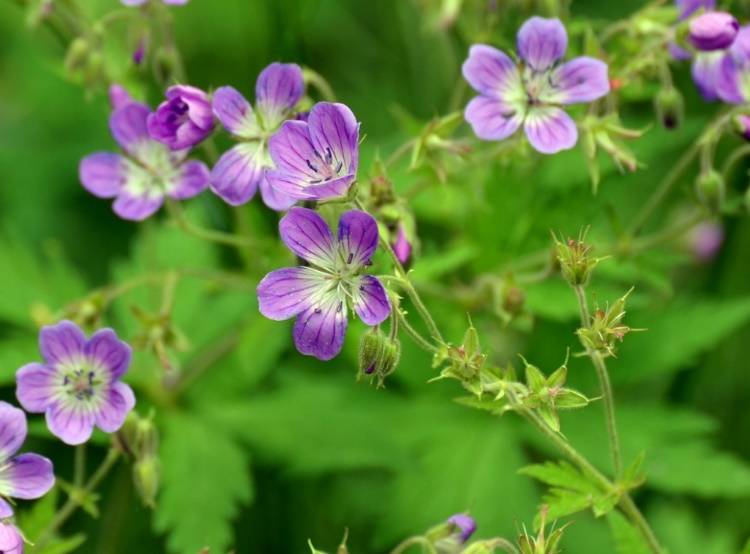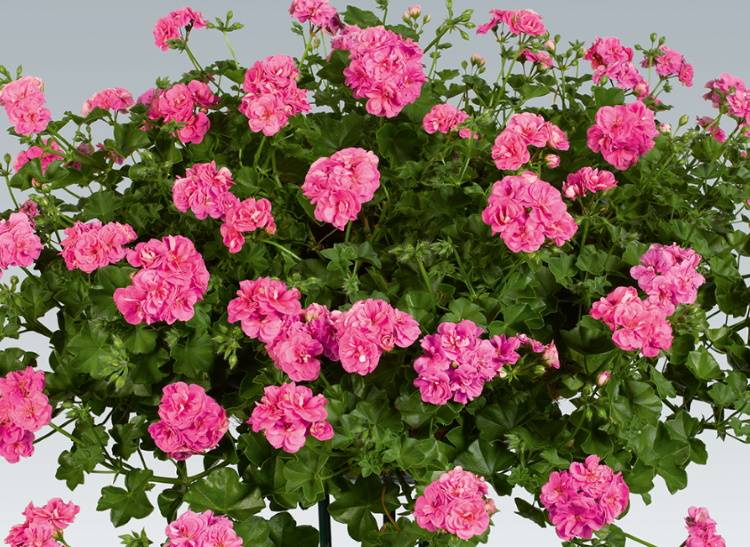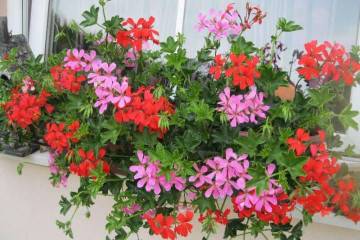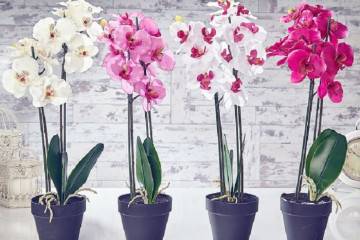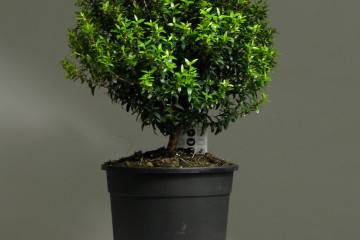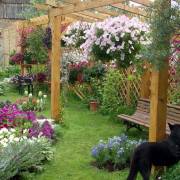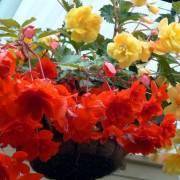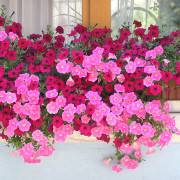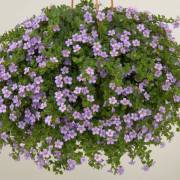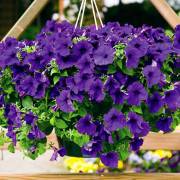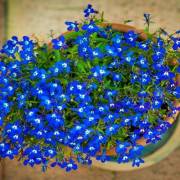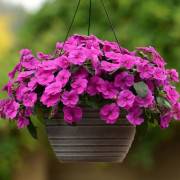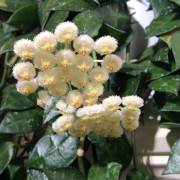How to propagate ampelous geranium at home
Content:
Once the botanists, thermophilic grandmother's balls and frost-resistant, growing in the open ground, half-shrubs of the crane were attributed to the same Geranium family (Geraniáceae) and began to call both types of plants geraniums (Geranium). Then scientists renamed tropical kalachiki to Pelargonium, but by inertia, many amateur flower growers still call indoor flowers geraniums, despite the fact that the scientific name Geranium is now attributed only to cranes. The ivy-shaped geranium, care and reproduction of the flower are described below.
Ivy ampel geranium: care and reproduction
Many people want to decorate rooms in winter, in spring and summer, the walls of their houses and gardens with flowering hanging branches of ampelous pelargoniums. Home propagation will help to get many beautiful plants; ivy geranium is easy to grow from seeds.
Ampel Pelargonium is used not only for hanging decoration, but also as ground cover plants.
To grow ampelous Pelargonium, you can use one of the following sowing methods:
- in a soil mixture with embedding in the ground to a depth of not more than 0.5 mm;
- in an open way in a mini-greenhouse on wet paper;
- into peat tablets.
All three methods will help to propagate plants at any time of the year. But in autumn and winter, in conditions of short daylight hours, seedlings, in order to successfully root and not stretch out, will need additional lighting with special phytolamps.
How to propagate pelargonium using seeds
Elongated ivy pelargonium seeds differ from ordinary geraniums in that they have a larger size and a dense surface. It is convenient to pick them up with tweezers, they are clearly visible on the soil surface, and even more so on light-colored paper.
Seeds of unconfirmed quality must be disinfected with any fungicidal preparation and encouraged to grow with a rooting stimulator. For these purposes, fungicides phytosporin, fast, epin stimulants, succinic acid, and sprout are used.
For fast germination and rooting, large seeds with a hard shell are sometimes subjected to scarification - thinning of the protective coating of seeds with the help of an abrasive material.
Sowing with embedded in the ground
For this sowing method, it is necessary to prepare or purchase a loose soil substrate for Geraniums with a neutral acidity level. Homemade soil can consist of garden soil with the addition of deoxidized high peat and sand.
To give the soil mixture sufficient looseness, it is passed through a sieve, and to disinfect it, it is steamed in the oven. After heating and cooling, the substrate is spilled with a phytosporin solution.
Low boxes, bowls or pots with drainage holes are chosen as a planting container. They must be washed in a disinfectant, dried, and then filled almost to the top with a moistened soil substrate.
Seeds are laid out on the surface of the soil, maintaining a distance of 2-3 cm, then sprinkled with a very thin layer of dry substrate. The surface of the soil is once again moistened with a fine-droplet water spray.
The landing boxes are covered with transparent glass or plastic, taken out into a warm room (20-25 ° C). Every day from the boxes for 20-30 minutes. remove the shelter, check the soil moisture, water if necessary.
After 2 true leaves are formed on the seedlings, they are transplanted in containers up to 15 cm high. You can root seedlings either one at a time in individual pots, or several pieces in wide common containers.
How to root ivy geraniums by sowing on wet paper
7 layers of toilet paper are placed on the bottom of a transparent plastic container with a transparent lid. It is moistened, the seeds are spread over the paper. The container is closed with a lid and placed in a warm, well-lit place. Airing and moistening of paper is carried out.
Sprouts with two cotyledonous leaves will appear at about 10 days. They cannot be allowed to take root in the paper; they are transplanted into individual plastic cups with tweezers. The cups are covered with transparent bags and placed under phytolamps until real leaves appear.
How to root ivy pelargonium by sowing in peat tablets
Geranium seeds can root perfectly in peat tablets. Use mesh tablets. They are placed in a common tray, water is poured onto the bottom. After the tablets have increased in size, the seeds are laid out in the central recesses located in the center. The pallet is closed with a transparent lid, water is added to the bottom as needed.
How to cut and root ivy pelargonium
Cuttings of ampelous pelargonium are carried out with sharp disinfected instruments. Green cuttings cut from bushes in spring and summer take root most quickly (in 10-15 days). Semi-lignified cuttings will take about 3 weeks to root.
Step-by-step process of grafting ampelous pelargonium:
- Choose healthy stems of uterine geraniums, cut cuttings from them with a length of at least 5 cm.
- 2-3 leaves are left at the top, the rest are cut off.
- The cut is treated with activated carbon crushed into powder.
- Cuttings are left in the open air for a day.
Planting transparent cups with pre-made drainage holes with a volume of 50-100 ml are filled with a nutrient substrate. It can be a mixture of black soil from your own garden with high peat in a 1: 1 ratio, purchased soil, coconut fiber. Any of the selected substrates is well moistened with a fungicide solution.
A recess is made in the center of the cup. The stalk must be planted so that its lower end almost touches the bottom of the cup, and the lower bud is 2-3 mm higher than the level of the planting substrate. The glass is placed in a pallet, placed in a shaded place with a temperature not higher than 25 ° C and not lower than 15 ° C. After 3 days, the stalk is taken out closer to the light, but at noon it is removed away from the scorching sun.
How to pinch ampel geranium
Whether it is necessary to pinch ivy pelargonium is decided based on which plant you want to see in front of you: a beautifully formed dense bush or pelargonium with rare long flowing stems.
Pinching leads to the fact that after removing the growth point from the top of the branch, lateral shoots begin to form. The plant spends additional forces on this, the budding process slows down, the flowering time is postponed. But as a result, a profusely flowering bush is obtained, because the buds are laid on the side shoots.
The pinching is done simultaneously with the pruning of weak and broken branches, excess leaves. The procedure can be carried out in warm weather several times a month. In the winter months, when indoor pelargoniums have a dormant period, it is better not to disturb the flowers.
Pinching becomes a reason for additional cultivation of flowers, because pieces of stems suitable for grafting can be cut from plants.
How to plant an ampelous geranium in a flowerpot
The root system of the Geranievs is located in the surface layer of the soil; it does not penetrate to great depths. Therefore, the plants are planted in shallow flower beds, filled almost to the brim with soil mixture.
If a hanging planter is preferred for growing room ampel pelargonium, then a design with drainage holes in the main pot and a solid attached pallet is chosen. This type will allow you not to pollute the floor in the room and prevent the roots of the plant from rotting.
You need to care for pelargonium planted in a hanging planter in the same way as for plants in ordinary pots. Rare abundant watering is carried out. In the spring they are fed with complex nitrogen fertilizers, during the flowering period they use potassium-phosphorus fertilizers. In autumn, the flowers are not fertilized, they give them the opportunity to prepare for the winter dormant period.
Ampel ivy-leaved pelargoniums are grown and reproduced without much difficulty. Experienced gardeners say that cuttings of these flowers take root and take root much better than other types of Geraniums. This is probably why they can increasingly be seen hanging from the balconies of high-rise buildings, in city parks, on personal plots, on the walls and window sills of apartments.
